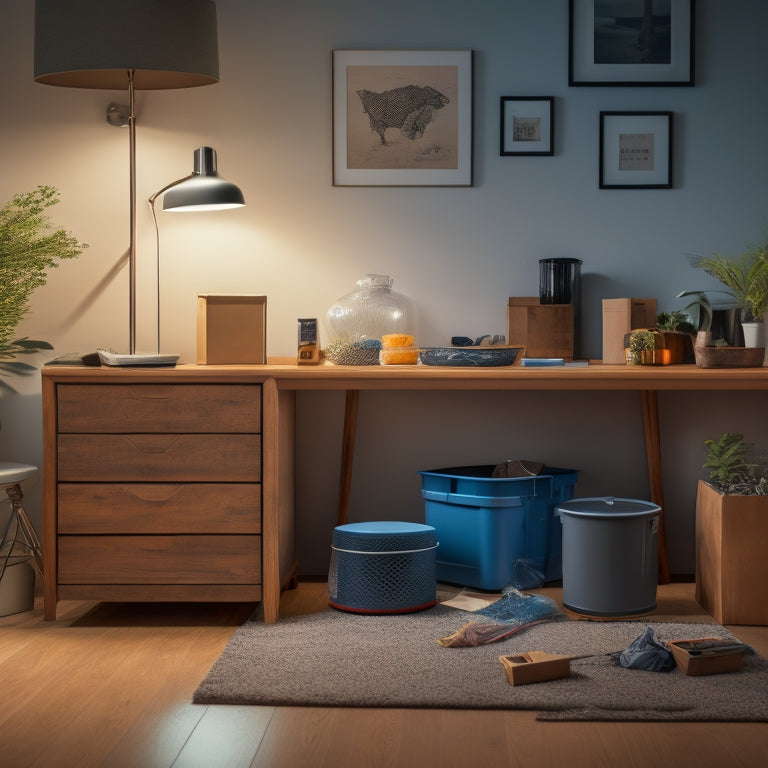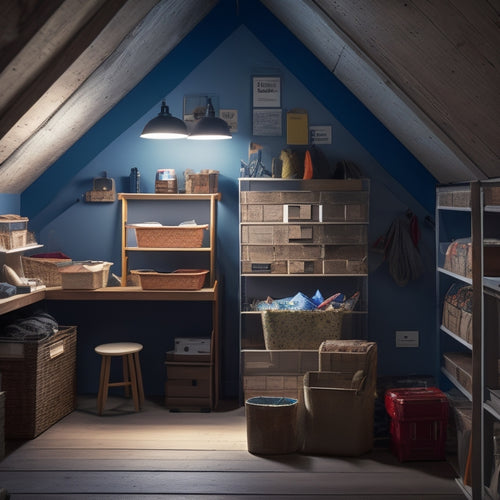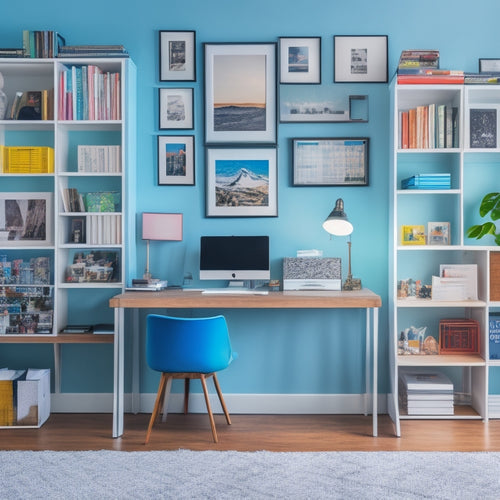
10 Essential Tools for Decluttering Your Home
Share
You're about to discover the top 10 essential tools you never knew you needed to declutter your home efficiently. Start with decluttering apps like Habitica and Declutter to streamline your process, and task management systems to break down projects into manageable chunks. Digitize important documents with cloud storage services like Google Drive and Dropbox, and create a room-by-room plan to tackle hotspots like entryways and countertops. From labeling and signage solutions to home inventory management systems, you'll find the right tools to maximize your space and energy. Now, get ready to transform your space and your life with the essential tools that will take your decluttering to the next level.
Key Takeaways
• Utilize decluttering apps like Habitica, Declutter, and TaskRabbit to categorize and prioritize tasks for a streamlined process.
• Implement digital organization and storage solutions like Google Drive and Dropbox to access important documents from anywhere.
• Incorporate productivity tools like efficient storage solutions and labeling systems to maximize time and energy.
• Leverage customized storage planning software and virtual design tools like RoomSketcher or Floorplanner to optimize furniture placement and maximize space.
• Establish habit-forming decluttering reminders, such as schedules and accountability partners, to maintain consistency and motivation.
Decluttering Apps for Easy Organization
You can streamline your decluttering process by leveraging technology, starting with decluttering apps that help you organize and prioritize your tasks efficiently. With so many options available, it's crucial to read decluttering app reviews to find the one that best suits your needs. These apps can help you categorize and prioritize tasks, set reminders, and track your progress.
Some popular decluttering apps include Habitica, Declutter, and TaskRabbit.
To maximize the effectiveness of these apps, incorporate smartphone organization tips into your daily routine. Set up separate folders for different areas of your home, such as 'living room' or 'kitchen,' and create subfolders for specific tasks, like 'donate' or 'recycle.' This will help you quickly access and update your tasks on-the-go.
Additionally, set reminders and notifications to ensure you stay on track and focused. By utilizing decluttering apps and implementing smartphone organization tips, you'll be able to tackle your decluttering tasks with ease and efficiency.
Task Management for Home Projects
Now that you've got your decluttering tasks organized digitally, it's time to break them down into manageable chunks by creating a task management system tailored to your home projects. This will help you stay on track, ensure assurance, and make the most of your time.
Here are some essential components to include in your task management system:
-
Project timelines: Establish realistic deadlines for each task to maintain momentum and motivation.
-
Task delegation: Identify tasks that can be delegated to family members or friends, and assign them accordingly to share the workload.
-
Home project collaboration: Designate a shared space, like a whiteboard or online platform, where everyone involved can track progress and communicate effectively.
- Accountability partners: Assign a buddy or partner to hold you accountable for completing tasks on time, providing an added motivation to stay on track.
Digital Storage for Important Documents
Organizing important documents digitally is crucial for decluttering your home, as it frees up physical space and allows for easy access to essential papers. By digitizing your documents, you'll reduce clutter and make it easier to find what you need when you need it.
Consider using cloud storage services like Google Drive, Dropbox, or iCloud to store your digital documents. These services provide secure, accessible, and cost-effective storage options.
To guarantee easy retrieval, create a file organization system that makes sense to you. Set up folders and subfolders for different categories, such as 'Taxes,' 'Insurance,' and 'Receipts.' Within each folder, create clear and concise file names that include dates and descriptions. This will help you quickly locate specific documents.
Additionally, consider scanning and digitizing paper documents, such as receipts and contracts, to reduce physical clutter. By implementing a digital storage system, you'll be able to access your important documents from anywhere, at any time, and enjoy the peace of mind that comes with a clutter-free home.
Room-by-Room Decluttering Guides
When you're ready to tackle a room, you'll want to start with a clear plan of attack.
You'll need to identify the hotspots that tend to accumulate clutter, like entryways and countertops, and prioritize those areas first.
Then, you'll want to tackle the hidden areas, like closets and cupboards, that often get overlooked but can harbor a lot of clutter.
Start With a Plan
To tackle your decluttering project efficiently, create a customized room-by-room plan that breaks down the task into manageable chunks, allowing you to focus on one area at a time. This approach helps you prioritize your time and energy, making the process less overwhelming. With a clear plan in place, you'll be able to allocate sufficient time for each room, ensuring that you're not rushing through the process.
Here are some essential steps to include in your plan:
-
Set specific goals: Identify what you want to achieve in each room, such as 'sort through closet' or 'declutter kitchen countertops.'
-
Schedule dedicated time: Allocate specific days and times for decluttering each room, ensuring you have enough time to complete each task.
-
Prepare necessary supplies: Gather boxes, bags, and other necessary materials before starting the decluttering process.
- Practice mindful decluttering: Take your time to thoughtfully consider each item, asking yourself if it's worth keeping or letting go of.
Focus on Hotspots
Now that you have a solid plan in place, it's time to explore the nitty-gritty of decluttering by focusing on the hotspots in each room that tend to accumulate the most clutter. These areas require a special kind of attention, as they're often the most challenging to organize.
Adopt a decluttering mindset and tackle these hotspots room by room. Start by identifying the trouble spots, such as the kitchen counter, entryway, or desk. Then, break down the task into manageable chunks, and create a hotspot organization plan tailored to each area.
As you work through each hotspot, you'll encounter decluttering challenges that require creative solutions. For instance, you might need to find a way to store bulky items, like winter coats or out-of-season decorations. Don't be discouraged – hotspot solutions can be as simple as investing in storage bins or installing shelves.
Tackle Hidden Areas
You've conquered the hotspots, but it's time to turn your attention to the hidden areas in each room that secretly harbor clutter and disorganization. These areas may not be immediately visible, but they can contribute significantly to the overall sense of chaos in your home.
Here are four key areas to focus on:
-
Closet organization: Don't overlook the hidden gems in your closet, such as the back of the door, the top shelf, or the floor. Invest in double rods, shelves, and bins to maximize storage and keep items off the floor.
-
Garage cleanup: The garage is often an underutilized space that can become a dumping ground for clutter. Sort items into categories, install shelving and hooks, and consider a slatwall for added storage.
-
Under-bed storage: Use bed risers or storage bins to utilize the space under your bed for items like linens, out-of-season clothing, or luggage.
- Behind-the-door storage: Take advantage of the space behind doors by installing hooks, shelves, or over-the-door organizers for items like jackets, bags, or cleaning supplies.
Productivity Tools for Busy Homeowners
By incorporating the right productivity tools into your decluttering routine, busy homeowners like you can maximize their time and energy. When it comes to decluttering, every minute counts, and using time-saving decluttering techniques can make all the difference.
Invest in efficient storage solutions like stackable bins, baskets, and shelves to keep your belongings organized and out of sight. This won't only free up space but also reduce the time spent searching for misplaced items.
Streamlining home organization is key to maintaining a clutter-free home. Identify areas that need the most attention and prioritize them accordingly. Create a schedule and set realistic goals for each decluttering session.
Maximizing space utilization is essential, especially in small homes or apartments. Consider using multi-functional furniture or wall-mounted storage units to optimize your space. By implementing these strategies, you'll be able to declutter efficiently, stay organized, and enjoy a more peaceful living environment.
With the right productivity tools, you can achieve your decluttering goals and maintain a home that's both beautiful and functional.
Labeling and Signage Solutions
How can you ensure that your newly organized spaces remain clutter-free and easy to navigate for the long haul? One pivotal step is to implement effective labeling and signage solutions. This will help you and your household members quickly identify where items belong, making it easier to maintain your hard-won organization.
Here are some DIY labeling ideas and creative signage solutions to get you started:
-
Chalkboard labels: Use chalkboard stickers or paint to create labels that can be easily updated as your storage needs change.
-
Color-coded labels: Assign specific colors to different categories (e.g., blue for cleaning supplies, green for gardening tools) to create a visual system that's easy to follow.
-
Picture labels: Use images or icons to label items that are challenging to describe with words, such as tools or craft supplies.
- Shelf dividers with labels: Use dividers with built-in labels to separate items on shelves and keep them organized.
Home Inventory Management Systems
When you're decluttering your home, having a system in place is crucial for keeping track of what you own and where it's stored. A home inventory management system helps you do just that, ensuring you can easily locate items and make the most of your storage spaces.
Track Your Belongings
You'll be amazed at how much easier it is to declutter and organize your home once you've implemented a home inventory management system to track your belongings. This system helps you keep tabs on what you own, where it's located, and its condition.
With a clear picture of your belongings, you'll make more informed decisions about what to keep, donate, or discard.
Here are some benefits of tracking your belongings:
-
Easy inventory tracking: Quickly identify what you have and where it's stored.
-
Belongings management: Keep track of items that need maintenance, repair, or replacement.
-
Reduced stress: Stop worrying about lost or misplaced items.
- Increased efficiency: Save time searching for items and focus on more important tasks.
Organize Storage Spaces
Set up a home inventory management system to categorize and allocate storage spaces, ensuring everything has a designated place and making it easier to find what you need. This system will help you optimize your closet organization and kitchen pantry, among other areas. By assigning a home to each item, you'll reduce clutter and make the most of your storage spaces.
Here's a breakdown of how to allocate storage spaces effectively:
| Storage Space | Tips for Organization |
|---|---|
| Closet | Use shelves and double rods to maximize vertical space, and consider a shoe organizer for additional storage. |
| Kitchen Pantry | Install shelves and baskets to categorize food items, and label each section for easy access. |
| Attic or Basement | Use clear storage bins and labels to identify contents, and consider a shelving system for bulkier items. |
| Garage or Shed | Install hooks for hanging items like bikes and tools, and use shelving units for storage bins and containers. |
Decluttering and Organizing Coaching
Hiring a professional decluttering and organizing coach can provide you with the personalized guidance and support you need to overcome emotional attachment to clutter and develop sustainable organizing habits. A coach can help you identify the root causes of your decluttering challenges and create a customized plan to tackle them.
With their expertise, you'll receive:
-
Personalized guidance: A coach will work with you to understand your unique needs and create a tailored approach to decluttering and organizing.
-
Accountability: Regular check-ins with your coach will keep you motivated and on track, ensuring you stay committed to your goals.
-
Progress tracking: Together, you'll monitor your progress, celebrate successes, and adjust your strategy as needed.
- Emotional support: A coach will offer empathy and encouragement, helping you navigate the emotional aspects of decluttering and organizing.
Customized Storage Planning Software
When it comes to customized storage planning software, you'll find that it's a game-changer for decluttering your home.
You'll be able to organize your space and visualize your ideal storage setup with virtual room design tools.
Organize Your Space
You'll find that customized storage planning software helps you visualize and optimize your space, identifying areas where clutter tends to accumulate and providing solutions to maximize your storage capacity. This tool enables you to create a digital representation of your space, allowing you to experiment with different layouts and storage configurations.
Here are some ways customized storage planning software can help you organize your space:
-
Identify clutter hotspots: Pinpoint areas where clutter tends to accumulate, and get suggestions for creative storage solutions to tackle them.
-
Optimize furniture placement: Experiment with different furniture arrangements to find the most space-efficient layout for your room.
-
Maximize vertical space: Get ideas for using wall-mounted shelves, storage units, and other space-saving solutions to make the most of your ceiling height.
- Create a minimalist decor: Use the software to design a minimalist space that emphasizes simplicity and functionality, while maximizing your storage capacity.
Virtual Room Design
With virtual room design, you're empowered to recreate your space digitally, testing various layouts and storage configurations before lifting a finger to physically rearrange your furniture. This technology allows you to experiment with different virtual design trends, ensuring you find the perfect arrangement for your needs.
Online room planners, such as RoomSketcher or Floorplanner, offer user-friendly tools to create a 2D or 3D model of your space. Simply input the dimensions of your room, add furniture and decor, and adjust the layout to your heart's content.
Habit-Forming Decluttering Reminders
Set reminders on your phone or calendar to dedicate a specific time each day or week to decluttering, making it a habit that sticks. This way, you'll ensure that decluttering becomes a consistent part of your routine. Daily reminders can be especially helpful in keeping you on track and motivated.
Here are some additional strategies to help you form habit-forming decluttering reminders:
-
Create a decluttering schedule: Plan out which areas of your home you want to tackle and when, and set reminders accordingly.
-
Find an accountability partner: Share your decluttering goals with a friend or family member and ask them to hold you accountable.
-
Join a declutter challenge: Look for online communities or social media groups that offer decluttering challenges and reminders to keep you motivated.
- Make it a habit loop: Create a habit loop by linking decluttering to an existing daily habit, such as right after breakfast or before bed.
Frequently Asked Questions
How Do I Motivate Myself to Start the Decluttering Process?
To motivate yourself, you're setting specific, achievable goals and rewarding progress. Visualize your clutter-free space, then share your goals with a friend to establish accountability, ensuring you stay committed to transforming your living area.
What if I'm Overwhelmed by Sentimental Items I Don't Want to Part With?
When you're overwhelmed by sentimental items, acknowledge your emotional attachment, then try organizing techniques like categorizing, grouping, or taking photos to help you let go, and remember, it's the memory that's precious, not the item itself.
Can I Declutter My Home if I Have Limited Mobility or Energy?
Imagine waking up in a clutter-free space, despite limited mobility or energy. You can achieve this by implementing adaptive solutions, like accessible organization systems, and adopting low energy decluttering strategies that prioritize efficiency over exhaustion.
How Do I Involve and Get Cooperation From Family Members in Decluttering?
You'll achieve successful decluttering by understanding your family dynamics and assigning tasks to create a sense of teamwork, making it a collaborative effort that fosters cooperation and a shared sense of responsibility.
What's the Best Way to Dispose of Hazardous Waste During Decluttering?
'You're drowning in a sea of hazardous waste! Take a deep breath and tackle it systematically. Guarantee proper disposal by taking safety precautions, exploring recycling options, and considering professional services - it's better to be safe than sorry!'
Related Posts
-

What's the Secret to Organizing Digital Clutter?
You're tired of feeling overwhelmed by digital mess, wasting time searching for lost files and drowning in a sea of d...
-

Unlock Attic Storage Potential With Online Guides
You're sitting on a treasure trove of storage space, right above your head! Reveal your attic's hidden potential by a...
-

Top Digital Tools for Home Organization Success
To achieve home organization success, you'll want to tap into the power of digital tools. Start with decluttering and...


